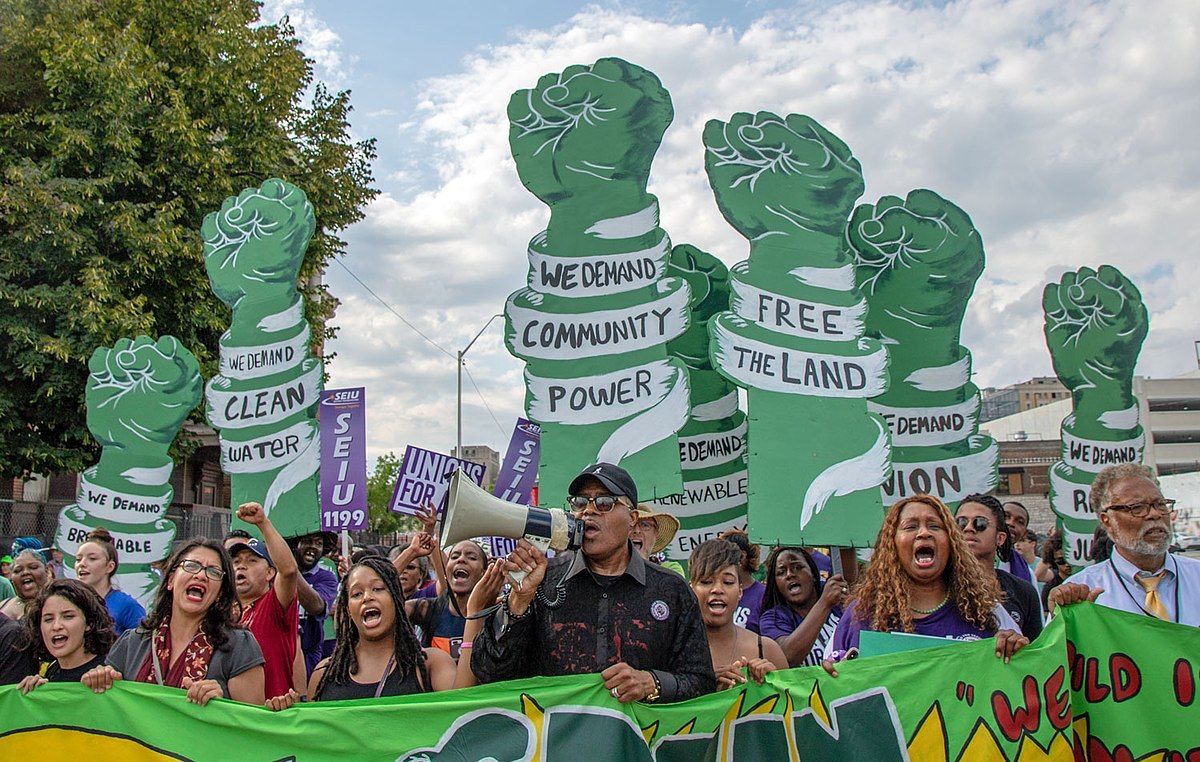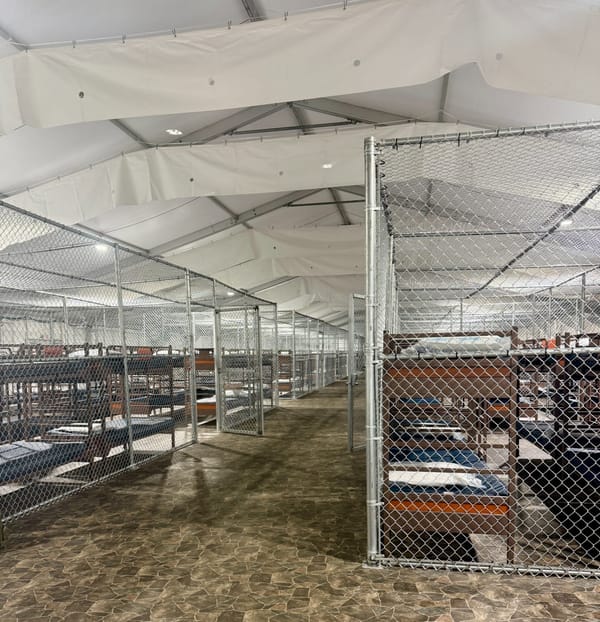Liberals of the Anthropocene

Liberals have an environmental problem. Many, if not most, liberals understand that climate change caused by greenhouse gas emissions and associated environmental problems require a concerted political response. Yet as a political movement fundamentally committed to the value of the individual, liberalism hasn’t always had much to say about value in nature. Human freedom has often been understood as the freedom to dominate nature.
But environmental problems have plagued humanity since before the modern era and will always be with us. If we want to stay relevant, liberals need to find a way to take environmental values as deeply into our theoretical bosoms as we do free speech, the rule of law, and representative government. Traditional liberal virtues of forbearance and openness to social change will need to be supplemented with green virtues of respect for nature and preservation. This points to a need to move beyond valuing nature for purely instrumental reasons. We have instrumental reasons for finding non-instrumental value in nature.
An environmental theory that recognizes value in nature that is non-instrumental and non-anthropocentric—not everything reduces to usefulness for humans—is an ecocentric theory. Ecocentrism is a troublesome word because it looks like it means the environment is the foremost value, but all it means in the environmental ethics literature is that nature is valuable in and of itself, and not only valuable in terms of how it benefits humanity.
Liberals versus Greens
The relationship between liberalism and environmentalism is fraught, to say the least. Environmental political theorist Robyn Eckersley tidily summarizes the Green view of liberalism:
What is needed … is a fundamental reexamination of the basic axioms of liberalism such as possessive individualism, private property, limited government, and market freedom … [I]t was the unleashing of the passion for material abundance, legitimized by Hobbesian natural right, amplified by Locke, combined with the rejection of the classical commitment to reason and proper limits that caused the ecological crisis.
Eckersley 17
In Environmentalism and Political Theory, Eckersley goes on to summarily dismiss liberalism (along with conservatism) as a self-evidently unserious and unviable approach to environmental problems.
The feeling is mutual. The early Green movement was so explicitly, almost comically, authoritarian that it has been largely toxic to liberals until, perhaps, the beginning of the 21st century. Economist Robert Heilbroner pressed the case for authoritarian central planning as a necessary transition to Ancient Greek-style city-states, while ecologist William Ophuls bemoaned the “Herculean task [of] reforming a corrupt people” and regretfully concluded the only options were “Leviathan or oblivion.” More enduring in liberal memory is the “population bomb” doom-mongering of Paul Ehrlich, who would advocate remarkably racist and imperialist population control on the poor world, including mass coercive sterilization campaigns. These were not fringe figures, but central voices.
The Green movement has always been explicitly leftist and anti-capitalist, birthing ecofeminist, eco-anarchist, and—in a time when the world was still gripped in the nuclear fist of the Cold War between the Union of Soviet Socialist Republics and the liberal West—ecosocialist movements. These associations poisoned the “eco” prefix in many liberal minds.
Yet Greens get the broad strokes of liberalism’s history right. Liberalism arose as a self-conscious political movement for bourgeois rights and representative government and against aristocratic privilege and absolutist monarchy. This loosely coincided with the early stirrings of the first Industrial Revolution, before the advent of large scale environmental problems, or at least before we had the conceptual tools to watch out for environmental dangers. The natural environment was simply not an element of the liberal ontology.
Among the sources of inspiration for early liberals were champions of private productive property like John Locke, who argued that land only gained value upon human exploitation. Social contract theorists like Locke and Thomas Hobbes would bequeath to their liberal heirs a strict methodological individualism. Philosophers of the Scottish Enlightenment like David Hume and Adam Smith would celebrate the emergence of the commercial society and the greater “opulence” it would bring.
Liberalism was thus founded on ideas that would be toxic to environmentalists in the 20th century: land and nature ordained for exploitation; individualism against holistic values and social organization; commerce, industry, and wealth accumulation as the cheerful purposes of humanity.
Oblivious to these petty anthropic antagonisms, the biosphere continues to bake.
An ecoliberalism of fear
Liberals had decent excuses for not thinking about the long term cumulative effects of, say, burning coal to produce the energy needed to power the cornucopian engines of industrialization. No one could have predicted global warming from greenhouse gas emissions in 1800, nor the sudden untethering of human population expansion from Malthusian constraints.
Yet humans have irrevocably impacted the environment since at least the advent of agriculture. The introduction of humans to new environs has tended with some regularity to the extinction of megafauna. Human indifference to ecology hasn’t always gone so well even for humanity. Civilizations from ancient Maya and Minoa to Easter Island are usually understood to have brought about their own destruction by felling one too many trees and causing desertification.
The ecological challenge is thus far from new. But its global reach is entirely novel. It is one thing for some geographically limited ancient empire, however mighty, to lay itself low by excessive resource extraction or by defiling its waters. It’s another thing altogether for atmospheric spillover effects from chlorofluorocarbons and greenhouse gases to alter the human habitability of the planet itself.
Human beings have since the Agricultural Revolution made a lasting impression on the biosphere. For the past ten millennia or so we have thus had a plausible claim to dominant influence, but the Industrial Revolution augured the Anthropocene Era, where there is no question that Homo sapiens singularly control the fate of the biosphere. This human-led fate is one of increasing temperatures, rising sea levels, and shifting weather patterns that threaten draughts, famines, climate refugee crises, and the political turmoil that accompany these ills.
Climate change compels liberals to take environmental concerns seriously, if only to prevent and mitigate mass human suffering from climate disasters. We can understand this in entirely liberal terms. Externalities from burning fossil fuels harm individuals who would not otherwise be at risk. The general welfare is reduced in terms of both individual suffering and the growing public expense in insurance and relief efforts. Individual rights will be harder to defend as social problems and zero-sum conflicts over scarce resources proliferate. And the brunt is disproportionately borne not by those privileged rich world citizens who have contributed the most to global warming but instead those in poor countries who are the least to blame.
Liberals understand all this and in many cases are prepared to countenance large scale government action in order to solve the climate crisis: public investment in renewable energy, electrification, and carbon reduction efforts. Unprecedented effort is required to meet an unprecedented global challenge. But it’s a mistake to see the climate change resulting from growing greenhouse gas concentration in the atmosphere as a singular challenge. Novel environmental problems will continue to present themselves as our material and energy footprint not only grows but changes. This is not a criticism of economic growth, just an assessment of its consequences.
Just as the use of chlorofluorocarbons as refrigerants—perfectly reasonable in itself—degraded the earth’s protective ozone layer, the burning of fossil fuels led to greenhouse gas emissions that would alter the habitability of the planet. Alternative refrigerants were straightforward to find and deploy. Alternative, non-emitting energy sources are more complicated to find simply because our energy footprint is rapidly increasing both with population (that will level off in a few years) and with rising energy-intensive living standards. We’re making great headway in solar, wind, and battery storage.
But the solar hockey stick has its own costs. Lithium and other minerals used in solar panel manufacturing must be mined, and this can be an ecologically and geopolitically nasty affair. Expanding geothermal energy and thermal heat storage will require use of the destructive hydraulic fracturing techniques that have kept oil companies profitable. Of course we should launch a nuclear renaissance, and the environmental costs of fission energy are overstated by traditional Greens, but they aren’t vanishing, and uranium and other fissile materials aren’t without limit.
The point is all solutions to our environmental problems tend to generate new environmental (and political) problems of their own. This is not a counsel of despair or even of pessimism—green energy abundance is a moral imperative. Instead it’s a cold acknowledgment that there is no environmental silver bullet. There are tradeoffs and breakthroughs that generate still more tradeoffs. We will be playing ecological whackamole as long as we are the dominant animal on the planet. And the scale of environmental problems will not diminish but grow.
But an ecoliberalism of fear, where we are moved to act only in response to existential crises, is a rickety foundation. The green liberal philosopher Simon Hailwood is likely correct that emphasizing only the dire threats of climate change (and other environmental problems) can lead to a “dismal instrumentalism” that perversely demotivates collective action. It gives the entire subject of environmentalism a grim cast, and the very existential nature of the threats inspires a general skepticism which can be harnessed by economic actors who stand the most to lose by the radical solutions of the doomsayers. With all due respect to the liberalism of fear then, we need to activate the more cheerful and meliorist modes of liberal thought. Indeed, along with categorically rejecting misanthropy and authoritarianism, the possibility of moving beyond doom and gloom is one of the benefits of fashioning an eco-liberalism.
My task for the rest of this essay is to present a potpourri of reasons why liberals—to our credit usually resolutely humanist—should adopt ecocentrism. This generates risks and tensions with other liberal tenets. A defining feature of liberalism is the disestablishment of any particular conception of the good. A liberal society is a deeply diverse society in which all individuals are free to come to their own conclusions about—and pursue—the good life and no one religion or way of life is treated as correct. Liberalism is usually also seen to emphasize the individual’s rights and freedoms so that the individual is the ultimate locus of value. Does ecocentrism violate these liberal pillars?
Liberal praxis
Many self-understanding liberals passionately pursue not only action against climate change but environmental clean-up, land preservation, and animal welfare. Alexander von Humboldt set the ecological stage for early liberalism and this baton was passed to mid 19th century ecoliberals like John Stuart Mill and Charles Darwin. The progressive movement in America since at least Teddy Roosevelt has had a green wing, and this open-spaces flavor of ecoliberalism was once shared by a subset of liberal conservatives. Nowadays a large body of liberals is driven by the existential logic of climate change to focus their activism on environmental concerns.
One example of nascent ecoliberalism is the ecomodernists, whose manifesto endorses liberal democracy and emphasizes intensification of human civilization and separation from nature. Thus: zero carbon energy like nuclear energy in addition to renewable energy, genetic engineering for more efficient crops and use of land, dense urbanization to reduce the human ecological footprint, and rewilding as much nature as possible. Some of these policies run roughshod over traditional eco-sensibilities, so ecomodernists haven’t exactly had the green welcome mat rolled out for them.
The Green New Deal represents an alternative instantiation of ecoliberal values. The GND advocates a massive public investment in green energy, industries, and infrastructure in order not only to limit climate change but to achieve a number of other ecological health goals. Like the original New Deal, the GND is conceived as a state-fostered mobilization of workers across several economic sectors and therefore includes a number of social welfare policies to alleviate dislocation caused by the transition. Unlike the original New Deal, the GND explicitly seeks to improve the welfare of marginalized groups so they don’t get the raw end of policy tradeoffs that so often plagues race- and sex-blind reforms.
On the liberal interpretation of the GND, its purpose is to coordinate public resources to solve the mother of all collective action problems and ensure that liberal capitalism and the abundance it ushers forth are broader, fairer, and more sustainable going forward. The GND represents a gargantuan deployment of state resources and applies a green thumb to the industrial scale but it fundamentally retains liberal institutions of entrepreneurial capitalism, respect for the individual seeking her fortune by her own lights, and a dynamic open society. The degrowth movement—which is explicitly hostile to the “productivism” of the GND—provides an illustrative contrast: central planning, suspicion of individual betterment and free initiative, and an intrinsically closed society.
Liberal ecocentrism
Clearly liberals from various backgrounds can endorse green values at the policy level for any number of reasons. But how can a good liberal think about ecocentric—that is to say, non-human-centered—values? We can start by looking for resonances in liberal and ecological ways of thinking.
Liberals of a Hayekian persuasion, attuned to spontaneous order arising from individual actions without overarching intentional design and alert to unintended consequences of top-down attempts to reorder society, should see themselves reflected in the language of ecology. Barry Commoner’s four laws of ecology—”everything is connected to everything else, everything must go somewhere, nature knows best (i.e., any major human intervention in a natural system is likely to be detrimental to that system), and there is no such thing as a free lunch” (Eckersley 37)—could have been written by a free market economist. Indeed the division of labor and occupation of evolutionary niches play important conceptual roles in ecology. In an ecosystem, species perform specific jobs in the overall energy and materials economy.
One hiccup in this analogy for free market liberals is that it is impossible to avoid intervening in nature. Our inventions and innovations we rightly celebrate mean we perpetually threaten natural equilibria. Just as the libertarian philosopher Robert Nozick observed how “liberty upsets patterns,” so does liberty—and economic development generally—upset natural equilibria. We must intervene in the “natural economy” but do so with some ecological savvy. The inevitable ecological collective action problems that transcend property lines and political boundaries point to the need for coercive state action. This is especially true for global environmental problems, where the nation state is the obvious agent for collective action. This provides a corrective to naive libertarianism: any market order is already undergirded by a coercive political order defining all sorts of contracts, legal statuses, and relationships. Clarifying the legal boundaries of environmental impacts from a liberal perspective cements the statist nature of the liberal order.
The capabilities liberalism of Martha Nussbaum explicitly calls out a universal human capability, worthy of recognition and protection, “to live with concern for and in relation to animals, plants and the world of nature.” Nussbaum assembles her capabilities list by observation of universal human interests across cultures, interests that together constitute a “fully human life.” Thus liberals influenced by the capabilities approach recognize natural value instrumentally for the sake of humans. Nussbaum herself extends the capabilities approach to non-human sentient animals, who have their own distinct modes of flourishing that are also worthy of recognition and protection, for their own sake. Non-human animals, like humans, have certain requirements from their environments to thrive. If we are sufficiently attentive to these interests, we must at least value ecosystems and the greater biosphere indirectly, for the value they bring to human beings and animals we value intrinsically.
A recurring theme in progressive liberalism—from Wilhelm von Humboldt, J.S. Mill, and T.H. Green in the 19th century to Nussbaum and Amartya Sen and any number of progressive movements in the 20th century—is freedom as the open-ended unfolding of human potential. Human flourishing, of course, is compatible with comprehensive conceptions of the good, like specific religious traditions or totalitarian political movements. Open-ended flourishing, where human potential is activated to some objective threshold of functioning but the individual is left to choose their own adventure, retains the essential character of liberalism.
But the emphasis on flourishing opens us to the intrinsic value of anything that can flourish (or languish). Sentient animals can flourish by living in an environment suitable for their distinctive natural ends. So too can plants, fungi, and even holistic natural entities like ecosystems. The philosopher Paul Taylor defends a “biocentric” ethic wherein a thing qualifies as an end in itself when it is a “unified system of organized activity, the constant tendency of which is to preserve its existence by protecting and promoting its well-being.” Tayler limits this to living organisms, but ecocentric theorists have noted the same idea applies equally well to living systems.
Nature has purposes that are fully independent of human purposes. A thought experiment I keep coming back to is simply pondering if anything we would call value would have arisen had human beings with our rational minds not evolved. I reckon there was already something intrinsically valuable the first time a proto-biomolecule began exploiting its surroundings for material to replicate itself. Or a variation: Should the apocalypse arrive and humanity vanishes from the face of the earth, do we care whether or not nonhuman life shares our dark fate, which is to say, do we care if Gaia herself persists? In both cases my intuition points powerfully to the intrinsic value of persistent nonhuman life. But if we care about nonhuman life in the absence of human life, we should likewise bestow proper respect on nonhuman life and its various purposes alongside our own.
Ecoliberals can also draw inspiration from the land ethic of Aldo Leopold and the expanded earth ethic of J. Baird Callicott. These thinkers—with impeccable green credentials—may not have identified as liberals, but their ethical theories are rooted—by way of the notably liberal Charles Darwin—in the empirical, sociological pluralism of the Scottish Enlightenment, especially David Hume and Adam Smith, often counted among the founding fathers of liberalism. And both have distinctively liberal humanist approaches, emphasizing how ecocentric values supplement our more familiar moral commitments to family, community, country, and global humanity. In the land and earth ethic, plants, animals, and ecosystems are considered part of the broader biotic community in which humans are themselves but “plain citizens.” Humans have to treat nature with care and respect, but not at the sacrifice of strong human interests.
Gus diZerega is a notable example of a Hayekian “evolutionary liberal” who extends liberal theory along similar lines as Leopold and Callicott. DiZerega conceives of our ethical commitments to four communities: family, the local community, the broader society, and nature. These ethical commitments overlap and can conflict. “Public policy should seek to provide an environment conducive to harmonizing and sustaining the relationships which sustain all four.”
Still other liberals value nature for a variety of metaphysical and confessional reasons. The simple fact is liberals will bring these deeply personal ideas about what is valuable in nature into the discursive and legislative arenas and this shouldn’t alienate them from their liberalism out of an overzealous fixation on political neutrality. This does not mean the state would be recognizing an official creed.
Indeed the state has its own reasons for protecting nature: preserving natural resources, providing public goods in the form of parks and wilderness, scientific inquiry, increasing air and water quality, limiting climate change and other environmental dangers to citizens and global humanity, and just perhaps promoting the general welfare, including the broader biotic community. It is in the state’s interest then for citizens to bring their distinctive environmental perspectives into the public forum. Because of these interests, the state should even promote environmental awareness among citizens in as even-handed a way as possible. This does compromise neutrality, but this is a pretty minor misdemeanor, less serious than referencing God on the currency and on par with state education and official speech aimed at promoting racial integration, religious tolerance, and the value of diversity—all thick normative commitments that contradict the comprehensive doctrines of some citizens. As in these cases, the free speech of dissenting anti-environmentalist citizens should of course be protected.
Green promethean fire
Ecocentrism is not against humans per se or the celebration of humanity’s special forms of excellence; rather, it is against the ideology of human chauvinism. Ecocentric theorists see each human individual and each human culture as just as entitled to live and blossom as any other species, provided they do so in a way that is sensitive to the needs of other human individuals, communities, and cultures, and other life-forms generally.
Eckersley 56
What, then, does a viable ecocentric liberalism look like? Like all liberals, ecoliberals should work toward a society that respects individual rights and promotes the free development and flourishing of individual human capabilities. The human individual—these words will remain tied together while non-human and individualism necessarily fall apart—is still the ethical and political unit of ecoliberalism. But animals, species populations (animal and non-animal), and whole ecosystems are recognized to have moral worth and are owed consideration in both individual human ethics as well as community and state policies. At the personal level, ecoliberals should cultivate norms conducive to the flourishing of our local species and ecosystems and the biosphere. We should promote a culture that fosters these values alongside and enmeshed with other traditional liberal humanist values.
Ecoliberals should build institutions that protect and advocate for non-human entities. We can think of non-human interests and ecosystems like intermediate institutions within our human society—something like how religious institutions, professional organizations, labor unions, and non-governmental organizations feature—or we can think of non-human natural entities as more like foreign interests—foreign powers or quasi-independent indigenous nations. Nature is different, and our own interests in respecting the independent purposes of the natural world and the instrumental human interests in natural resources simply can’t be perfectly captured by analogy to any other entity. But those interests are real, worthwhile, and compatible with the more orthodox liberal worldview.
Human excellence and human flourishing are a matter of debate and interpretation. For Eckersley and many non-liberal ecocentrists, human flourishing consistent with proper respect for nature requires a dramatic diminution of human presence, including reducing—surely in a humane way—human population, certainly reducing our social metabolism. But this doesn’t have to be the case for the ecocentric liberal, who may reasonably have very different notions of human excellence and prosperity even while sincerely desiring to respect and care for their biotic communities and the greater biosphere.
The ecoliberal can retain the meliorism and even the prometheanism of the liberal tradition. The creative powers of science and engineering can be channeled in ways that promote human health, welfare, expansion of life opportunities, and even frivolous fun, without succumbing to the temptations of Abrahamic domination of nature. The urbanist liberal who experiences a spiritual high amid the hustle and bustle of the commercial megalopolis can rest assured that dense urban living is green living, even as there is always more civic and political greening work to do. Indeed the global environmental crisis itself points toward the necessity of unleashing a green promethean fire. We have to organize our political economy to build solar and wind (yes and nuclear) power, electrify our infrastructure, build battery and other storage capacity, reforest and rewild the planet, and clean our atmosphere and waters. Clean energy superabundance, as ecoliberal Brink Lindsey observes, unlocks capabilities to solve a host of other environmental problems, especially those of carbon- and land-intensive agriculture and cruelty-intensive industrial meat production.
Lindsey captures the ecoliberal mood perfectly:
Imagine, though, that we succeed. We have managed to stabilize the climate. We have learned how to feed ourselves without disrupting the rest of life on this planet. As humanity’s agricultural footprint steadily shrinks, we can witness and celebrate as nature bounces back, endangered species flourish again, and old crop and pasture lands revert to wilderness. … [Our relationship to the biosphere], adversarial since early humans first started hunting megafauna to extinction, will be transformed to custodial: humanity will have marshalled its powers, not to threaten the rest of life on this planet, but to protect it and facilitate its flourishing. We can even make up for past sins by resurrecting lost species. We can make the earth one vast, beautiful garden.
And it will be clear that this beautiful garden of a world is a distinctly human achievement — and specifically a technological achievement. Calling this age the Anthropocene Era can become a statement of pride, not a rebuke.
Central to the liberal worldview is the acceptance of the fallen-world reality of trade-offs and the impossibility of free lunches. This animates the ecoliberal approach to environmental policy, such as the hard sacrifice of habitats to mine the materials that will facilitate renewable energy. But the ecoliberal rejects with prejudice the fundamental, value-level contraposition of human flourishing against the thriving biosphere. We can at least strive for a harmony of interests.
The ecoliberal rejects the authoritarian and frankly anti-human tendencies of certain corners of the environmentalist movement. But just as importantly, the ecoliberal embraces both the human coexistence with nature as an inextricable permanent feature of the Anthropocene Era and the ecocentric, intrinsic value of nature—animals, species, ecosystems, and the biosphere. Ecoliberalism patches the green gap in liberal theory and practice. And to the environmental movement, the ecoliberal comes in peace, offering both the normative authority of liberal theory, the cavalry of political coalition, and a powerful alternative vision of a future of ecological revival and unbounded human potential.
—
Featured image is Make Detroit the Engine of the Green New Deal.




